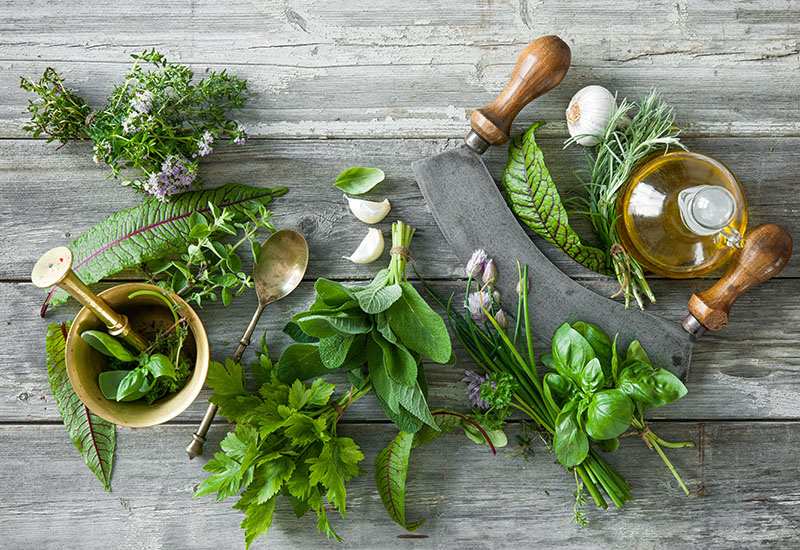Green is the color of spring, and nothing says spring more than fresh greens! While salads are a great way to get a good dose of greens into your daily diet, don’t forget about fresh green herbs. Any salad, meal or dish can be enhanced with the addition of fresh herbs (and roots too), and because culinary herbs contain aromatic oils, they’re filled with additional nutrients and health benefits that lettuce, spinach and kale simply do not offer.
It is extremely beneficial to use fresh herbs daily in moderate quantities, as they are packed with many health-boosting compounds. This is the foundation of the Mediterranean diet. Pesto for instance, uses basil as its base with plenty of garlic, both of which offer significant nutritional benefits. Za’atar uses wild thyme and oregano as its base and Chimichurri uses fresh parsley and oregano. Many cultures use green herbs in daily condiments for flavorful health benefits and a good dose of chlorophyll. These are kept on hand, made available for everyday use and eaten liberally.
If you choose to use fresh green herbs as a garnish, they’ll offer culinary and visual appeal, as well as health benefits and subtle flavor. Even small amounts of herbs like fresh mint, parsley, dill, bay leaf, ginger root, turmeric and garlic can stimulate the appetite and aid digestion.

The Rich History of Fresh Herbs
For more than 5,000 years, herbs and spices have held a strong, significant role in cooking. Most culinary herbs were eaten for their pleasant aroma, flavor and ability to preserve foods long before it was understood that they held other beneficial properties. People cherished their local herbs and cultural traditions for utilizing them.
Throughout ancient history, references to the culinary use of herbs and spices were eventually documented, and their health benefits became more well-known and understood as the spice trade routes evolved and expanded. It is only in the past century that common knowledge of the full spectrum of health benefits of herbs waned in the mainstream public, only to be on the rise again in the last few decades.
People now recognize the need to be more health aware and are connecting more with the ways of our older generations. Everything comes full circle as we revisit the deeper wisdom of our ancestors.

The Origins of Fresh Herbs
Many of the culinary cooking herbs that we use today originate in other countries. Sage, for example, is a very hardy Mediterranean herb that grows well in other regions. Cilantro is native to Southern Europe and Northern Africa. Ginger, as we know it, is native to China and Turmeric originates in India. We currently have a melting pot of fresh herbs available to us year round, and their health benefits are literally at our fingertips.
Ways to Use Fresh Herbs in Cooking
- Fines Herbs: This is a traditional blend used in classic French cuisine consisting of finely chopped fresh parsley, chives, tarragon and chervil. If you cannot find chervil, you can substitute with either flat leaf parsley and a little fennel or tarragon, or combine your own favorite herbs for a unique signature flavor.
- Herb Bouquets: In traditional European cooking, herb bouquets are bunches of fresh herb bundles tied together with kitchen twine and placed whole in soups, stews or roasters making it easy to remove from the dish when the cooking is complete.
- Bouquet Garni: A classic French blend of fresh herbs used for soups, stews, stocks, casseroles, meats and vegetables. Traditionally parsley, thyme, bay leaf, leek leaves and peppercorns are tied in a cheesecloth bundle, but you can also replace the cheesecloth with steamed leek leaves that are folded into a bundle and tied with string.


How to Make Fresh Herb Teas
Many cultures have used their native fresh herbs to make healthful teas. Herbs such as fennel, dill, sage, basil, parsley, thyme and even bay leaves are commonly used in teas for the health benefits that they offer.
Simply take 1 tablespoon of fresh chopped herbs, or a few long sprigs, and place them in a teacup or mug, lightly crushing the herbs to release the aromatic oils. Bring 6-8 oz. of water (spring or purified) to a low boil. Pour the water over the herbs and steep for 5-10 minutes. Strain the tea (you can eat the herbs) and drink as is, or add a small amount of honey, maple syrup or even a slice of citrus fruit and zest. Cold herb teas are very healthful and refreshing in the summer season.
The Health Benefits and Uses of Culinary Herbs
Basil: A beautiful, bright green leafy herb that is high in antioxidants and contains anti-inflammatory and immune supportive properties. Basil is said to stimulate hormones responsible for creating a sense of happiness and increased energy. It supports the nervous system, digestive system, lungs, liver and brain. In Mediterranean countries, people believed that eating basil at night promoted sleep and drinking a tea in the morning promoted alertness.
- Use: Make a basil tea with lemon and honey, crushing the leaves before steeping. It is a classic herb used in pesto, summer salads and sandwiches or paired with tomatoes and avocados. Basil can be snipped fresh over cooked vegetables, soups, pasta, beans and lentils.
Bay Leaf: The leathery leaf from an evergreen tree, bay has a warm resinous flavor, which has an affinity for supporting the digestive system and helps to break up and eliminate fats. It also has a mild diuretic property and can ease bloating. Used as a mild tonic, it can help to lift the spirits, which is why the Greeks and Romans believed that bay leaves could bring happiness and aid artistic inspiration.
- Use: Tear the leaves before using to release the oils and use in the beginning of cooking. One leaf is all that you need to make an aromatic and uplifting cup of tea. It can also be used in soups, sauces, casseroles, and vegetable dishes, as well as with beans and lentils.
Chives: Related to onions, leeks, shallots and garlic, chives are high in antioxidants, anti-inflammatory compounds and vitamin C. They are also a good source of choline, can boost bone strength due to Vitamin K content and can help protect against chronic disease.
- Use: With a mild flavor, chives are great in eggs, potatoes and fresh salads and dressings. They are also great sprinkled over fish, beans and most vegetables.
Cilantro: A naturally strong-flavored herb used worldwide in many ethnic dishes, cilantro can stimulate digestive enzymes, relieve indigestion, support blood sugar levels and protect against oxidative stress. It can help to calm your nerves, lower anxiety and improve sleep. Cilantro is antimicrobial and anti-inflammatory. It also supports the cardiovascular and urinary systems and helps to cleanse the liver and increase mental function.
- Use: A cooling herb, cilantro is used in guacamole, salsas, traditional Mexican dishes, chilis, soups, stews, pasta salads and sour cream. It brightens up any dish with its fresh flavor.
Dill: Used liberally, dill leaf can help with digestion, fight infections and support healthy cholesterol levels. It can also help relieve coughs, support the kidneys, boost immunity and help to calm hiccups. In addition, it is considered to have some sedative properties, so it can help with sleep if eaten at night.
- Use: Dill is wonderful chopped fresh over fish and salads or sprinkled on cucumbers and beets. It is also delicious in bean dishes, soups and stews and can be used to flavor dairy and nut cheeses.
Garlic: Renowned worldwide for both its flavor and therapeutic benefits, the use of garlic goes back to ancient Egypt, 4,500 years ago. It is known for its antiseptic action and has been thoroughly researched and documented in both the West and the East. It is considered to have a warming and strengthening action on the respiratory system and serves as an expectorant. It also supports healthy circulation and cholesterol levels. High in Sulphur compounds, it also supports the collagen production in the body and, if nothing else, helps keep the vampires away!
- Use: Powdered garlic and garlic salt are not as beneficial as fresh garlic. Therapeutically, garlic is best when used raw. Garlic enhances many dishes with its warm flavor and aromatic fragrance. Use it liberally with vegetables, whole grains, beans, meats, soups, pasta, salads, hummus and dips.
Black Garlic: Used as a medicinal herb since the Middle Ages, black garlic is a fermented form of garlic. The fermentation alters the taste, making it sweeter and milder. It also makes the nutrients more bioavailable. Due to its high levels of antioxidants, black garlic can help reduce inflammation, improve memory and brain function and support nerve function and healthy cholesterol levels.
- Use: It works well as a garlic substitute in most recipes. Heinen’s offers prepackaged black garlic from Melissa’s Produce in the Produce Department.
Ginger Root: This naturally aromatic root with a hot, slightly sweet flavor can support circulation, metabolism, and digestion and relieve nausea related to motion sickness. Japan has the highest use of ginger in the world and the lowest incidence of disease. The dried powder does not have the strong citrusy undertone of the fresh root form.
- Use: Great in salad dressings and marinades, as a tea or flavoring for Asian stir fry dishes with tofu and chicken. It’s also great in rice dishes or served with carrots, leeks, onions, potatoes, pumpkin and cabbage. Ginger adds a warming flavor to stewed fruit and baked apples with cinnamon.
Oregano: A Mediterranean herb that grows wild, oregano has a warm, savory flavor. With powerful antibacterial, antifungal and antiviral properties, oregano also has strong anti-inflammatory properties and has been used extensively for many centuries in cooking.
- Use: Oregano gives the classic “Italian” flavor to tomato sauces, pizza and other dishes. It works well in pastas, sauces, soups, casseroles and with beans and lentils.
Marjoram: Used in a variety of traditional and folk remedies, marjoram can provide important health benefits. It has a sweet, warm flavor and is considered to be both toning and relaxing. It supports the nervous system, respiratory and digestive systems. It is anti-inflammatory and has a dualistic quality that soothes and invigorates.
- Use: Marjoram is wonderful in salads and stuffing, or snipped fresh over tomatoes or cooked vegetables. It also pairs well with meat and poultry.
Mint (Peppermint): With a pungent aroma and bright green leaves, mint has a scent that stimulates and awakens the appetite, making it great for digestion. It has been used since ancient times in both the East and West and is refreshing and uplifting. Mint begins as stimulating and warming and offers a cooling and refreshing affect when eaten. It is calming to the stomach and the intestinal tract and makes a wonderful after dinner tea.
- Use: It is refreshing in fruit salads and also compliments some meats like lamb. It pairs nicely with peas, carrots and potatoes. Mint tea is a classic remedy for indigestion and stomach issues.
Parsley: A mild herb with a fresh flavor, parsley offers a rich source of vitamins and minerals, is helpful for digestion, has antibacterial properties and ,as a natural diuretic, supports the urinary system. Dried parsley loses its flavor, so chopped fresh leaves are more desirable in cooking. Fresh parsley is commonly sprinkled generously over food after cooking.
- Use: Parsley combines well with almost all vegetables and is delicious served with fish, meat and salads. You can also use it in pesto and is a main ingredient in tabouli.
Rosemary: An herb with a warm aromatic flavor reminiscent of pine, rosemary has a toning action. It was considered a sacred plant in both Greece and Rome and contains a rich source of antioxidants and anti-inflammatory compounds. It has been said that it helps to sharpen the memory and concentration.
- Use: Try fresh-snipped rosemary over vegetables, with poultry, meat and fish, or in a mixed green or fruit salad.
Sage: Used and valued in ancient Egypt, Greece and Rome, sage was traditionally used for sore throats, upper respiratory support, and digestion. It has a strong flavor, so use sparingly. Sage also supports hormone balance for women.
- Use: Great with poultry, beans or in tea with lemon and honey. It can also be used in stuffings and stews.
Tarragon: Tarragon has long, slim, pointed leaves and a distinct licorice-like flavor. It acts mainly on the stomach and digestive system, is soothing and speeds up a slow digestion. Tarragon both stimulates and calms the nervous system, so it is particularly helpful with digestive imbalances caused by stress and nervous tension.
- Use: Tarragon can be used as a tea for digestion or snipped fresh over salads, fish, chicken and vegetables like potatoes, carrots, cabbage. It also goes well with cooked pears or in an herb salad along with parsley, mint, chives, fennel, sorrel, chervil and marjoram.
Thyme: A strong aromatic plant with a pungent flavor, thyme was used extensively by the ancient Egyptians, Greeks and Romans for both flavor and medicinal qualities. It has both a powerful antiseptic and relaxing quality, and both warms and tones the body. It supports the nervous system and respiratory and lung health. Thyme also soothes the digestive system, strengthens the immune system and is considered to cheer the heart and lift the spirit.
- Use: Thyme is an excellent herb for beans, whole grains, most vegetable dishes, stuffings, casseroles, and meat, chicken and tofu.
Turmeric Root: Used extensively in East India as part of Ayurvedic medicine, it is an excellent anti-inflammatory root. It is also a natural blood thinner and is excellent for treating digestive issues, inflammation of any kind and skin conditions. Finally, it supports healthy cholesterol, treats bodily discomfort and aids in weight loss.
- Use: Turmeric works well in rice, lentil and whole grain dishes, soups and stews. It pairs well with eggs and can be freshly grated in marinades for chicken, fish or vegetables. It is also used in East Indian curries and imparts the traditional cultural flavor.
Where to Find Fresh Herbs
While many people grow a few select herbs special to them in their spring and summer gardens, if you do not have your own garden, you can find a wide array of fresh herbs in your local grocery store. Heinen’s carries bundled fresh herbs in our cool rack, or prepackaged, precut fresh herbs by Great Lakes Growers and Buckeye Fresh in the refrigerated section of the Produce Department.
Our fresh ginger and turmeric from Melissa’s Produce, is never irradiated (most ginger is). Mine started to grow on my counter, and it never developed mold. Now that’s a living, healthy fresh herb!




